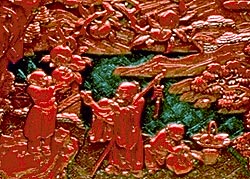| |
|

|
 |
 |


|
 |

1736-95 (Ch'ing dynasty)
Tricolor lacquer
Gift of Mr. and Mrs. Augustus L. Searle
|
Look
- This presentation box is covered with many
SYMBOLS
that wish the box's owner good luck and happiness. Find the Chinese character on the cover of the box. The character means
"spring," a fruitful and pleasant season. Find the bowl below the character. The bowl is filled with symbols of wealth.
What are they?
Coins and rhinoceros horns.
- Tell the story of Hsi Wang-mu and the peach tree.
What parts of the story do you see in this panel on the presentation box?
Gardens of Hsi Wang-mu, peach tree on the left.
Who is picking the peaches?
A boy.
Who is helping?
An old man and another boy.
Do you see Hsi Wang-mu in this panel?
No.

|
Detail of peach scene from the
Presentation Box |
|
- The artist who carved this box applied many layers of different colors of
LACQUER
on the wood box. After they dried he was able to carve through the layers to reveal the various colors.
How many different colors did he use when he painted the box with lacquer?
Two - black and red.
What color did he paint on first?
Black.
How can you tell?
Black is the bottom layer.
FOREGROUND
in a work of art is the area closest to the viewer.
BACKGROUND
is the area farthest away from the viewer.
How did the artist use color to distinguish between foreground and background in this carving?
Black makes up the background - the black areas are farthest away. Red makes up the foreground - red landscape and figures are closer to the viewer, literally on top of the black background.
- Where do you see PATTERN in the picture of the Land of the Immortals?
Black water and sky. Red ground that the figures stand on, and leaves on trees to the right.
Where else do you see pattern on the box?
Black and red border on outside edges, orange background on either side of the picture of the Land of the Immortals.
What kinds of tools would the artist need to carve these patterns?
Small sharp blades, such as razor blades or X-Acto knives, to achieve tiny details.
Think
- This box is called a Presentation Box because it was presented as a gift, probably to a member of the Chinese nobility. The
owner was free to put whatever he or she liked in the box. If you received a box like this as a gift, what would you put in it?
- The old man in the scene from Hsi Wang-mu's gardens carries a staff that bears the character shou, for long life, and identifies
him as the god of longevity.
Why might the god of longevity be in the gardens with the magic peach tree?
Whoever ate the fruit of the magic peach tree would live forever.
Other symbols that cover this presentation box stand for spring, wealth, and children.
On what occasion would it have been appropriate to give this box as a gift?
Although we can't know for sure, the symbols suggest that it may have been a wedding or birthday gift.
- Peaches suggest many things in Chinese culture, among them springtime, marriage, fertility, and long life. By depicting
SYMBOLS
such as a peach, the artist recorded a wish for the recipient of the gift to have happiness and a long life.
Can you think of a fruit that we typically associate with good health?
Apple.
Have you heard a proverb about the benefits of the apple?
An apple a day keeps the doctor away.
On the Dragon Robe for an empress, there was another, different symbol for long life.
Can you remember what it was?
The red shou character.
|
|
|











